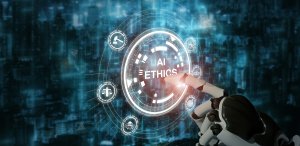Recent developments in AI have added fuel to debates that have long simmered amongst economists, which could lead to a rethinking of economics itself.
AI and Humanity: First the Good News
In markets hungry for the next big breakthrough the latest generation of Artificial Intelligence (AI) technologies has emerged as a potentially revolutionary force, offering a wide array of transformative benefits to humanity. With capabilities in processing data, making predictions, and automating tasks that would once have seemed like science fiction, AI is already altering the ways we live, work, and interact.
What does it mean for a doctor in an underserved area with limited resources to have access to AI systems that facilitate diagnoses based on symptoms and streamline care recommendations? For surgeons to have AI analyze a brain tumor in real-time so that they can decide how much to remove? Big data is already playing a significant role in drug discovery and development; researchers in many areas of academia, including economics, find analysis simplified and expedited.
There is increasing evidence that we are already seeing transformative changes in industries ranging from healthcare to finance. As AI can personalize cancer treatments,[1] identify and diagnose tumors mid-surgery,[2] and rapidly increase the discovery of new molecules that form the basis of drug discovery,[3] its lifesaving impacts are already being felt. In financial markets, it is being used to drive data analytics, data retrieval, predictions, and forecasting.[4] Innovation, often spearheaded by AI and machine learning, has given rise to new products, services, and business models. In education, the possibility of tailoring a curriculum to the needs and pace of each individual student could perhaps transform learning.
Even areas most associated with human creativity are tapping into the productivity benefits of AI. For example, journalists have been experimenting for the past few years with AI-generated content: the Associated Press has been using Natural Language Generation to produce narrative reports on earnings data and sports games, leaving journalists to focus on “critical qualitative articles.” In creative fields, imaging programs are turbocharging the productivity of designers and artists.
In many areas of the knowledge economy, current technological developments with Large Language Models like ChatGPT and Lama 2 and image developers like Dall-E, Stable Diffusion, and MidJourney as well as other rapidly developing areas of AI, are changing the productivity, efficiency, and every approach to work that we use, transforming what we are able to achieve.[5]
Which Way AI?
These developments have added fuel to at least two debates that have long simmered amongst economists. The first explores why the computer revolution never seemed to have the kind of obvious dramatic and long-term effect on global productivity that major innovations like electricity or the internal combustion engine and whether this time will be different.[6] The “Long Bet” between economists Robert Gordon and Erik Brynjolfsson epitomizes this, with Gordon proclaiming that AI is nothing new and that much of the economy will remain immune from its effects, while Brynjolfsson sees AI as a broad-purpose technology destined to affect every aspect of productivity.[7]
A similar debate rages between economists and technologists on the effects of AI on labor. Many economists, looking at the long arc of history, conclude that while technological change can cause job market disruptions, labor eventually gets reabsorbed in new tasks resulting in more and better-paying jobs.[8]
A recent study by McKinsey Global Institute attempted to quantify the effects of AI on labor markets by decomposing jobs into component tasks, evaluating those tasks that were most likely to be replaced by AI. It concluded that up to 30 percent of all hours currently worked across the US economy could be automated by 2030, requiring 12 million “occupational transitions.”[9] This fits with the approach many economists have taken in assessing the impact of technology on the labor market, pointing to the examples of Henry Ford shifting to assembly lines or the introduction of ATM machines, technological advances that created fear of major unemployment but instead resulted in increased employment, just in different tasks.
The reality, however, is that in the past three decades or so, despite the computer revolution and rapid technological change, median wages have remained stagnant while inequality has skyrocketed. A series of studies have found that automation of lower to middle-skill jobs has been a significant factor in job loss and wage inequality, much as Keynes predicted in 1930 when he highlighted the fear of “technical unemployment”. For example, Acemoglu and Restrepo (2017) find that the introduction of industrial robots in the US has had a significant negative effect on employment and wages [10] and Bonfiglioli et al (2023) find robust negative effects of AI on employment in US industrial zones, which are especially negative for low skill and production workers.[11]
It is also worth taking a moment to recognize what the process of reallocation of tasks looks like in reality. There are positive examples, as in the case say of the health insurance company Anthem, where digital automation has eliminated 10 million phone calls, handling those customer questions through digital channels. Rather than replacing its customer service workers though, Anthem has provided them with additional training, transforming them into “Care Navigators,” resolving customer problems directly rather than passing them on.[12] A very different experience can be found in an industry like metalworking. In a study of Italian metalworkers, economist Nadia Garbellini finds that with the introduction of AI, workers require less knowledge to perform assigned tasks, which are increasingly to operate complex machinery that is programmed by computer scientists and engineers outside the company, leading to an ever-increasing decline in workers’ feelings of autonomy.[13] Further, simply creating the AI algorithms that are being used requires thousands of people to train and label data. This is work generally being carried out in the global south, by what has been referred to as a “vast tasker underclass”, thousands of workers poorly paid for what is often tedious and repetitive labor.[14]
A useful approach to resolving some of the uncertainties is to build on the distinction some economists make between technology that substitutes for labor, thereby increasing unemployment, and that which complements labor, improving productivity without replacing humans. The current advances in LLMs seem, in many cases, to have led to a blossoming of productivity as many knowledge and creative workers learn to use this new technology to improve their output and increase their efficiency, replacing not just mundane repetitive tasks, but also creative ones. Anyone who has played with ChatGPT or MidJourney, for example, can verify that a few simple prompts can result in stories or artwork that are sometimes hard to distinguish from human output. There are, of course, the horror stories where LLMs fail at even the most basic math and make up facts out of whole cloth – the most colorful example perhaps being that of the lawyer who used ChatGPT to help prepare for a case and found himself citing fake cases in front of a judge, resulting in the threat of sanctions.[15] Ethan Mollick and others refer to this as the Jagged Technological Frontier, the combination of extreme capabilities and surprising weaknesses found in current AI technologies, pointing to a greater need to understand how to work effectively with them.[16] But as knowledge workers in various fields experiment with incorporating this new technology into their day-to-day work and the techniques improve, it is hard not to see the potential for a dramatic productivity and efficiency boost.
And studies are emerging that reinforce this picture. A recent paper by Brynjolfsson, Li, and Raymond finds that access to an AI-based conversational assistant for customer support agents improved productivity by 14%, with the lowest impact on low-skilled and novice workers.[17] Nielsen (2023) found that in a series of case studies the use of generative AI improved workers’ performance in customer service, routine business document creation, and coding projects by an average of 66%. And Mollick’s work with highly skilled consultants finds AI augmentation improves productivity by 17% to 43%.
If, indeed, the belief of many economists that AI will follow the path of other technological innovations so far, and that humans will adapt and find new ways to incorporate AI into our production models and simply find new tasks that humans can do that work with technology in more efficient ways that increase our productivity in the long term, then the only costs we may be looking for is a short to medium turn transition cost. By investing in education, promoting collaboration, redesigning work, and prioritizing ethical considerations, it could be possible to create a future where technology enhances human potential and well-being.
AI with Bette Davis Eyes
But what if instead we later look back on this time as “The Golden Age of Complementarity,” a time when both high- and low-skilled knowledge workers are finding ways to rapidly incorporate AI into daily tasks and increase their productivity? And what if, as with all golden ages, it is ephemeral? If, in fact, rather than being like ATMs or cars, AI by virtue of the fact that it can learn at arbitrary speeds over all areas of intelligent endeavor, is an entirely different kind of technology, and thus cannot be measured against previous innovations?
What if AI is instead like the understudy Eve Harrington, in the 1950s movie All About Eve, to humanity’s Margo Channing, patiently waiting in the wings for its moment to shine as it prepares to take over the lead actor’s role? In other words, that this is a time when AI is quietly honing its skills and learning the nuances of its craft to build its capability to step into the spotlight when the time is right.
Just as understudies learn their lines and cues from star performers, AI systems tirelessly observe and learn from the lead actor, training on vast amounts of data. Over time, AI may well become intimately familiar with the intricacies of the task it’s designed for, whether it’s speech recognition, image analysis, or autonomous decision-making, continuously improving and refining its abilities. It undergoes constant training and refinement and adapts to changing circumstances, learning from its mistakes and evolving in response to new challenges.
And AI has the perfect potential to outperform its human counterparts. It has the capacity to achieve levels of precision, speed, and consistency that humans can only dream of. It can process vast amounts of data in fractions of a second, make complex decisions based on multiple variables, and do so without fatigue or emotion. Furthermore, it is adaptable and versatile, seamlessly transitioning from one role to another, handling a wide range of tasks with ease. This versatility positions AI as a valuable asset in a variety of industries, from healthcare to finance, manufacturing to entertainment.
Same as it ever was? The displacement circle of life
During the first stages of any truly disruptive technology, there is usually a period of adaptation. Even after the handheld calculator was introduced by Jack Kilby in 1967, there were nine years of new US slide rules being produced to meet market demand until July 1976. While automobiles may have been introduced in the 1880s, only after 30 years of development did they displace horses in the streets of Manhattan.
The reason for this has to do with the fact that newer truly disruptive technologies almost always debut in brittle, clunky, and expensive forms with limited utility before standardization takes place. During this period the old mature technology co-exists with the newer aspirant until the advantages of the older technology are so insignificant that a general displacement takes place. San Francisco struggles daily with the co-existence of fleets of self-driving, AI-controlled cars sharing the streets with old-fashioned human-driven vehicles, with a host of attendant problems. But is there really a question about the direction in which this will be resolved? The charming horse-drawn carriages in New York’s Central Park are now simply a luxury good, ala Thorsten Veblen’s theory of the leisure class through the “Conservation of Archaic Traits” where they are valued as a form of conspicuous consumption.
So far what we mostly see is that ASI or Artificial Specialized intelligence has obviated the need for human labor in highly specialized occupations such as “chess player” or “Assistant Radiologist.” This is very much in keeping with past innovations that chase humans from one specialized niche into other areas of the labor market. However general intelligence and super intelligence will have a common signature across disciplines not only affecting the niche from which one is fleeing but also the other niches which would normally act as an absorber of labor.
Beyond Efficiency, Capitalism and Socialism: Does AI require a new economics?
While there is much discussion now about steering AI towards greater complementarity with humans and the need for reskilling and upskilling of labor to adapt to changing technologies, the bigger question is perhaps really one of time horizons. Every golden age eventually comes to an end. In the medium term, incentivizing innovation that prioritizes human-complementing technologies, and investing in education and development will be important in ensuring that the benefits of technological change can be broadly shared. In the longer term, though, we need to consider whether our current economic systems have the ability to sustain a fair and equitable society as the marginal product of median human labor declines below a living wage.
This, perhaps, is the main opportunity presented by the Golden Age of AI Complementarity. It is our time to think carefully about our systems of economic organization and what it would require to build a system that will find an accommodation for human intelligence and purpose when and if humans can no longer rely on superior intellect and creativity to create productive purpose within a market context for the fruits of our labor and ambitions.
Of course, that day may somehow never come. But if it does, our simplistic ‘efficiency biased economics’[18] may predictably return the answer that human beings have become a clunky albatross hanging from the neck of a machine made by Boston Dynamics.
Notes
[1] Ce, M. et al. March 2023. “Artificial Intelligence in Brain Tumor Imaging: A Step towards Personalized Medicine.” Current Oncology 2023 Mar 30(3): 2673-2701 https://pubmed.ncbi.nlm.nih.gov/36975416/
[2] Pasheva, E. July 2023. “AI Tool Decodes Bran Cancer’s Genome During Surgery” Harvard Medical School News. https://hms.harvard.edu/news/ai-tool-decodes-brain-cancers-genome-during-surgery
[3] Chopra, Y. May 2023. “The power of AI in Biotechnology: Revolutionizing Innovation.” https://www.datatobiz.com/blog/ai-in-biotechnology/ ; Vora, L. et al. July 2023. “Artificial Intelligence in Pharmaceutical Technology and Drug Delivery Design”. Pharmaceutics 2023 Jul; 15(7): 1916 https://www.mdpi.com/1999-4923…
[4] See for example Schroer, A. October 2023. “31 Examples of AI in Finance”. https://builtin.com/artificialintelligence/ai-finance-banking-applications-companies
[5] See for example Chen, T. May 2023. Wall Street Journal. “To Work Fewer Hours, They Put AI on the job.” https://www.wsj.com/articles/using-ai-shorten-work-day-b7e7126f ;Brynjolfsson, E., Li D., and Raymond L.R. 2023. “Generative AI at Work”. NBER Working Paper No. 31161. https://www.nber.org/papers/w31161 ; CNN July 12, 2023. “This CEO replaced 90% of support staff with an AI Chatbot” https://www.cnn.com/2023/07/12/business/dukaan-ceo-layoffs-ai-chatbot/index.html ; Dell’Acqua, F. et al. 2023. Harvard Business School Technology and Operations Mgt, Working Paper No. 24-013. “Navigating the Jagged Technological Frontier: Field Experimental Evidence on Knowledge Worker Productivity and Quality.” https://mitsloan.mit.edu/sites/default/files/2023-10/SSRN-id4573321.pdf ; Nielsen, J. July 2016. “AI improves Employee Productivity by 66%” https://www.nngroup.com/articles/ai-tools-productivity-gains/ ; Looney, M. Sept. 2023. “How Generative AI is changing the way creatives work.”. https://readwrite.com/how-generative-ai-is-changing -the-way-creatives-work/
[6] See for example Gordon, R., 2016. The Rise and Fall of American Growth. Princeton University Press.
[8] E.g., Autor, D.H., 2015. “Why are there Still So Many Jobs? The History and Future of Workplace Automation”. Journal of Economic Perspectives 29(3). https://pubs.aeaweb.org/doi/pdf/10.1257%2Fjep.29.3.3
[9] McKinsey Global Institute. 2023. Generative AI and the Future of Work in America. https://www.mckinsey.com/mgi/our-research/generative-ai-and-the-future-of-work-in-america
[10] Acemoglu, D. and Restrepo, P. 2017. “Robots and Jobs: Evidence from U.S. Labor Markets.” NBER Working Paper No. 23285. March. https://www.nber.org/papers/w23285
[11] Bonfiglioli, A. et al., 2023. “Artificial Intelligence and Jobs: Evidence from US Commuting Zones” CESifo Working Paper No. 10685. https://papers.ssrn.com/sol3/papers.cfm?abstract_id=4608807
[12] Lohr, S. May 2022. “Why isn’t New Technology Making Us More Productive” New York Times May 5th, 2022. https://www.nytimes.com/2022/05/24/business/technology-productivity-economy.html
[13] Parramore, L. 2023. “Labor Economist: AI May Bring a Book in Horrible Jobs.” INET Blog August 28, 2023. https://ineteconomics.org/perspectives/blog/labor-economist-ai-may-bring-a-boom-in-horrible-jobs
[14] Dzieza, J. June 2023 “AI Is a Lot of Work.” New York Magazine https://nymag.com/intelligencer/article/ai-artificial-intelligence-humans-technology-business-factory.html
[15] Bohannon, M. 2023. “Lawyer Used ChatGPT in Court-And Cited Fake Cases. A Judge is Considering Sanctions.” Forbes Magazine. June 2023. https://www.forbes.com/sites/mollybohannon/2023/06/08/lawyer-used-chatgpt-in-court-and-cited-fake-cases-a-judge-is-considering-sanctions/?sh=1fe689fb7c7f
[16] Dell’Acqua, F. et al. 2023. Harvard Business School Technology and Operations Mgt, Working Paper No. 24-013. “Navigating the Jagged Technological Frontier: Field Experimental Evidence on Knowledge Worker Productivity and Quality.” https://mitsloan.mit.edu/sites/default/files/2023-10/SSRN-id4573321.pdf
[17] Brynjolfsson, E., Li D., and Raymond L.R. 2023. “Generative AI at Work”. NBER Working Paper No. 31161. https://www.nber.org/papers/w31161
[18] Weinstein, E. 2016. Anthropic Capitalism and The New Gimmick Economy https://www.edge.org/response-…






